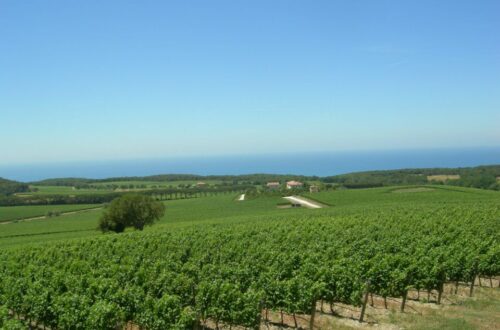Table of Contents
What is Pantelleria DOC?
Hidden between Sicily and the coast of Tunisia, Pantelleria DOC is one of Italy’s most captivating wine regions, famed for producing golden, aromatic sweet wines from the rare Zibibbo grape—also known as Moscato d’Alessandria. Here, ancient winemaking traditions meet the wild, windswept beauty of an island shaped by volcanoes, African breezes, and UNESCO-protected viticulture.
History and Origins
Pantelleria’s wine heritage dates back over 2,000 years, with the Phoenicians introducing grape cultivation and Arab settlers later bringing advanced irrigation techniques. The Zibibbo grape itself was likely introduced from North Africa, adapting perfectly to the island’s sun-soaked yet wind-lashed conditions.
In 2014, Pantelleria’s traditional “vite ad alberello” bush-training method became the first agricultural practice in the world to receive UNESCO Intangible Cultural Heritage status—a testament to its resilience and cultural significance.
Where It’s Made: Geography & Terroir
Pantelleria is a volcanic island roughly 100 km southwest of Sicily, closer to Africa than to mainland Italy. The terroir is defined by:
- Volcanic soils rich in minerals, perfect for aromatic grape expression.
- Dry, hot climate moderated by persistent Mediterranean winds.
- Terraced vineyards protected by low stone walls, sheltering vines from the sirocco winds.
The result? Grapes that retain concentrated sugars while developing intense floral and tropical aromatics.
The Grape: Zibibbo (Moscato d’Alessandria)
Zibibbo is a noble Muscat variety with an ancient lineage. In Pantelleria, it’s cultivated using low-trained bush vines planted in shallow hollows to shield them from the wind. The grape is prized for its thick skins, which help it withstand the sun, and for producing both luxurious sweet wines and refreshing dry styles.
Pantelleria DOC Wine Styles & Regulations
Under the Pantelleria DOC designation, wines must be made from 100% Zibibbo. Styles include:
- Passito di Pantelleria: Sun-dried grapes yield an opulent, amber-hued dessert wine.
- Moscato di Pantelleria: Lighter, aromatic, and sweet.
- Zibibbo Dolce Spumante: Sparkling sweet wine with exotic fruit notes.
- Dry Zibibbo: Increasingly popular for its saline minerality and citrus lift.
Key DOC Regulations:
- Grapes must be grown on Pantelleria.
- Sun-drying for Passito must occur naturally.
- Minimum alcohol: 14% for Passito; 10.5% for Moscato.
Key Facts at a Glance
| Specification | Detail |
| DOC Status | Granted 1971 |
| Region | Pantelleria, Sicily |
| Primary Grape | Zibibbo (Moscato d’Alessandria) |
| Signature Style | Passito di Pantelleri |
| UNESCO Recognition | Vite ad Alberello training method |
| Best Vintages | 2014, 2016, 2019, 2021 |
Tasting Notes
Expect golden amber hues with aromas of apricot, candied orange peel, jasmine, and Mediterranean herbs. On the palate, Passito delivers rich honeyed sweetness balanced by vibrant acidity, while dry Zibibbo offers citrus zest, sea spray, and wildflowers.
Serving & Pairing
- Ideal Serving Temperature:
- Sweet styles: 10–12°C (50–54°F)
- Dry styles: 8–10°C (46–50°F)
- Sweet styles: 10–12°C (50–54°F)
- Pairing Ideas:
- Passito: Sicilian cannoli, blue cheese, foie gras.
- Dry Zibibbo: Grilled fish, couscous, caponata.
- Passito: Sicilian cannoli, blue cheese, foie gras.
Where to Buy & Pricing
Pantelleria DOC wines are available at Italian specialty retailers, luxury wine merchants, and online platforms.
- Passito di Pantelleria: €25–€50 for a 375 ml bottle.
- Dry Zibibbo: €15–€30.
Top producers include Donnafugata, Pellegrino, and Marco De Bartoli.
FAQ on Pantelleria DOC
Q: Is Pantelleria DOC only sweet wine?
A: No—while it’s famous for Passito, it also produces dry and sparkling Zibibbo wines.
Q: How long can Passito di Pantelleria age?
A: High-quality examples can evolve beautifully for 10–20 years.
Q: Why is Pantelleria viticulture UNESCO-protected?
A: Its vine training method is uniquely adapted to extreme island conditions.
Fun Facts & Cultural Notes
- Pantelleria is nicknamed the “Black Pearl of the Mediterranean” for its volcanic rock.
- The island’s vineyards are often tended by hand due to steep, terraced terrain.
Arab influences linger in the island’s cuisine, making the wines’ pairing versatility remarkable.


